👉 Find out about The Open University's Geography courses. 👈
Explore the articles in this collection
-
Change in the West of Ireland
Read now to access more details of Change in the West of IrelandIntroducing a collection of articles asking 'How can unique and distinctive regions, like the West of Ireland, retain the qualities that make them unique while continuing to modernise and interact with the wider world?'

Article
-
Synthesis as a way of understanding the changing uniqueness of rural Ireland
Take part now to access more details of Synthesis as a way of understanding the changing uniqueness of rural IrelandWhat is synthesis? Discover how this way of thinking helps us to understand more about the way in which places retain their uniqueness within wider systems of interdependence.

Activity
-
Culture and regional distinctiveness
Read now to access more details of Culture and regional distinctivenessCulture and how language identifies that culture are key to understanding what makes a region unique.

Article
-
The rural dimension – rundale in the West of Ireland
Read now to access more details of The rural dimension – rundale in the West of IrelandThe rundale system once governed how farmland was distributed between tenants in Ireland. It supposedly died out in the 19th century, but this was not actually the case in some parts of the West of Ireland.

Article
-
The rural dimension – after rundale
Watch now to access more details of The rural dimension – after rundaleHow did the rural areas of Western Ireland change after the rundale system was replaced?

Video
-
A changing uniqueness – The changing ‘place’ of the West
Read now to access more details of A changing uniqueness – The changing ‘place’ of the WestThe population of Western Ireland declined dramatically between 1891 and 1961. How do you think this affected Ireland as a whole?
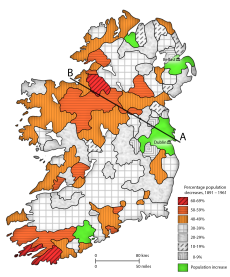
Article
-
The realities of rural life in the 1950s-1980s
Watch now to access more details of The realities of rural life in the 1950s-1980sThe period of the 1950s to 1980s was the beginning of modernisation in community life and farming and the development of manufacturing industry in the West of Ireland.

Video
-
Culture and the manufacturing industry, 1983
Watch now to access more details of Culture and the manufacturing industry, 1983In 1983, the fight to retain a unique Irish speaking culture meant that jobs had to be created locally in manufacturing and tourism so that Irish speakers no longer had to emigrate, but industrialisation also threatened the survival of the Irish language.

Video
-
The dilemma of tourism and the Irish language, 1983
Watch now to access more details of The dilemma of tourism and the Irish language, 1983Father James McDyer discusses the dilemma of the Glencolmcille holiday village between development, language and culture and the threat of depopulation. Tourism is important for economic development but what impact does it have on local culture and the Irish language?

Video
-
A new layer: Culture, the Irish language and identity in 2015
Watch now to access more details of A new layer: Culture, the Irish language and identity in 2015We revisit the Glencolmcille folk village in 2015 to see whether the dilemma of development and the local language and culture has been resolved.

Video
-
Southwest Donegal: uniqueness and interdependence in 2015
Read now to access more details of Southwest Donegal: uniqueness and interdependence in 2015In Southwest Donegal, we see both the local uniqueness and different interdependencies and interconnections with other places.

Article
-
The future of rural Ireland - nuances, scale and fighting back
Read now to access more details of The future of rural Ireland - nuances, scale and fighting backThe future of rural Ireland - nuances, scale and fighting back

Article
Where is the West of Ireland? Locational distinctiveness
The question of what, or where, the West of Ireland is, illustrates the problems of defining the distinctiveness and uniqueness of place. You may already have your own sense of what the West of Ireland is like in terms of its scenery and culture and this may differ according to whether you live in the area or are viewing it from afar! The landscape of rock, bog, lakes and isolated cottages is generally familiar through tourist promotion; the culture is often characterised by distinctive forms of music and dancing which are as familiar outside Ireland as within. The following video for the Wild Atlantic Way is an example of this:
The wet, windy climate, long winters and short growing season, the size of small farms, conservative attitudes and long history of emigration may all contribute to a less picturesque view of the West of Ireland, but they still do not say exactly where it is. To define and delimit the West of Ireland as a region means establishing criteria to convey the distinctiveness and coherence which have developed over time.
As you compare the five different maps here, notice how different criteria produce different definitions of 'the West of Ireland' (Use the ‘next’ button at the bottom of the box to move on to the next map)
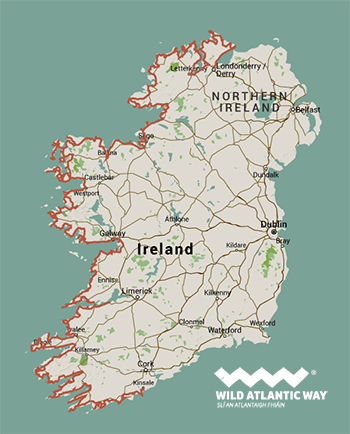 The Wild Atlantic Way
The Wild Atlantic Way
You might use the map of the Wild Atlantic Way, which
shows the 2575 kilometre coastal route along the West
coast of Ireland, described as ‘the world’s diverse and
most spectacular coastline’. It identifies points of interest
for visitors to Ireland.

Terrain
If you feel that remoteness and the physical environments have contributed significantly to the development of social coherence and distinctiveness in the West of Ireland, then a map of the coastal uplands might suffice. Here we've taken a map of the terrain and marked out a large number of the mountain peaks.
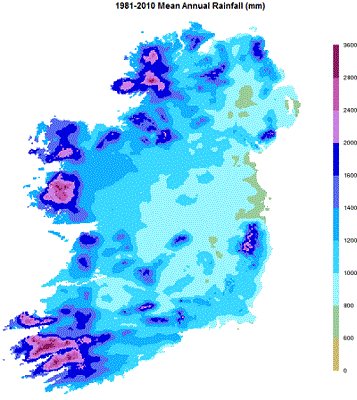 Rainfall
Rainfall
You could go a step further and look at figures for rainfall
or length of growing season, both of which are significant
to agriculture as the main economic activity in a rural region.

The Irish Meteorological Service has a map of mean annual rainfall in Ireland from 1981 to 2010.
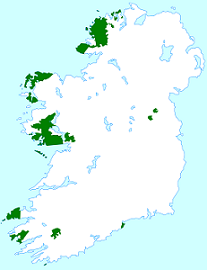 Language
Language
Alternatively, a cultural dimension could be selected as representing
development over time. In fact, language is used as the criteria for
delimiting the Gaeltacht, areas which qualify for special grants from
government in an effort to entertain a traditional Irish culture.
Language
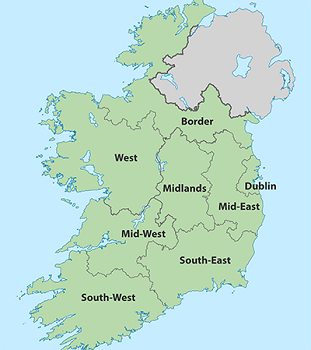 Administration
Administration
There is also a wider national framework of planning regions which, if planning is to be meaningful, should be comprehensive and reflect regional distinctiveness. The fact that they correspond to groups of counties suggest some sort of compromise with pre-existing administrative structures.
The Northern & Western Regional Assembly and Southern Regional Assembly have similar maps of the regions that they administer.
Explore the articles in this collection
-
Change in the West of Ireland
Read now to access more details of Change in the West of IrelandIntroducing a collection of articles asking 'How can unique and distinctive regions, like the West of Ireland, retain the qualities that make them unique while continuing to modernise and interact with the wider world?'

Article
-
Synthesis as a way of understanding the changing uniqueness of rural Ireland
Take part now to access more details of Synthesis as a way of understanding the changing uniqueness of rural IrelandWhat is synthesis? Discover how this way of thinking helps us to understand more about the way in which places retain their uniqueness within wider systems of interdependence.

Activity
-
Culture and regional distinctiveness
Read now to access more details of Culture and regional distinctivenessCulture and how language identifies that culture are key to understanding what makes a region unique.

Article
-
The rural dimension – rundale in the West of Ireland
Read now to access more details of The rural dimension – rundale in the West of IrelandThe rundale system once governed how farmland was distributed between tenants in Ireland. It supposedly died out in the 19th century, but this was not actually the case in some parts of the West of Ireland.

Article
-
The rural dimension – after rundale
Watch now to access more details of The rural dimension – after rundaleHow did the rural areas of Western Ireland change after the rundale system was replaced?

Video
-
A changing uniqueness – The changing ‘place’ of the West
Read now to access more details of A changing uniqueness – The changing ‘place’ of the WestThe population of Western Ireland declined dramatically between 1891 and 1961. How do you think this affected Ireland as a whole?

Article
-
The realities of rural life in the 1950s-1980s
Watch now to access more details of The realities of rural life in the 1950s-1980sThe period of the 1950s to 1980s was the beginning of modernisation in community life and farming and the development of manufacturing industry in the West of Ireland.

Video
-
Culture and the manufacturing industry, 1983
Watch now to access more details of Culture and the manufacturing industry, 1983In 1983, the fight to retain a unique Irish speaking culture meant that jobs had to be created locally in manufacturing and tourism so that Irish speakers no longer had to emigrate, but industrialisation also threatened the survival of the Irish language.

Video
-
The dilemma of tourism and the Irish language, 1983
Watch now to access more details of The dilemma of tourism and the Irish language, 1983Father James McDyer discusses the dilemma of the Glencolmcille holiday village between development, language and culture and the threat of depopulation. Tourism is important for economic development but what impact does it have on local culture and the Irish language?

Video
-
A new layer: Culture, the Irish language and identity in 2015
Watch now to access more details of A new layer: Culture, the Irish language and identity in 2015We revisit the Glencolmcille folk village in 2015 to see whether the dilemma of development and the local language and culture has been resolved.

Video
-
Southwest Donegal: uniqueness and interdependence in 2015
Read now to access more details of Southwest Donegal: uniqueness and interdependence in 2015In Southwest Donegal, we see both the local uniqueness and different interdependencies and interconnections with other places.

Article
-
The future of rural Ireland - nuances, scale and fighting back
Read now to access more details of The future of rural Ireland - nuances, scale and fighting backThe future of rural Ireland - nuances, scale and fighting back

Article
Acknowledgements
This material draws from an Open University course based on the work of Pat Jess.
-
Jess, P. (1985) ‘Unit 17 Local Change in the West of Ireland’, in The Open University (1985) D205 Changing Britain, Changing World: geographical perspectives, Broadcast Handbook, Milton Keynes, The Open University Press.
Rate and Review
Rate this article
Review this article
Log into OpenLearn to leave reviews and join in the conversation.
Article reviews